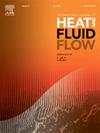Additive-feature-attribution methods: A review on explainable artificial intelligence for fluid dynamics and heat transfer
IF 2.6
3区 工程技术
Q2 ENGINEERING, MECHANICAL
International Journal of Heat and Fluid Flow
Pub Date : 2024-12-09
DOI:10.1016/j.ijheatfluidflow.2024.109662
引用次数: 0
Abstract
The use of data-driven methods in fluid mechanics has surged dramatically in recent years due to their capacity to adapt to the complex and multi-scale nature of turbulent flows, as well as to detect patterns in large-scale simulations or experimental tests. In order to interpret the relationships generated in the models during the training process, numerical attributions need to be assigned to the input features. One important example are the additive-feature-attribution methods. These explainability methods link the input features with the model prediction, providing an interpretation based on a linear formulation of the models. The Shapley additive explanations (SHAP values) are formulated as the only possible interpretation that offers a unique solution for understanding the model. In this manuscript, the additive-feature-attribution methods are presented, showing four common implementations in the literature: kernel SHAP, tree SHAP, gradient SHAP, and deep SHAP. Then, the main applications of the additive-feature-attribution methods are introduced, dividing them into three main groups: turbulence modeling, fluid-mechanics fundamentals, and applied problems in fluid dynamics and heat transfer. This review shows that explainability techniques, and in particular additive-feature-attribution methods, are crucial for implementing interpretable and physics-compliant deep-learning models in the fluid-mechanics field.
求助全文
约1分钟内获得全文
求助全文
来源期刊

International Journal of Heat and Fluid Flow
工程技术-工程:机械
CiteScore
5.00
自引率
7.70%
发文量
131
审稿时长
33 days
期刊介绍:
The International Journal of Heat and Fluid Flow welcomes high-quality original contributions on experimental, computational, and physical aspects of convective heat transfer and fluid dynamics relevant to engineering or the environment, including multiphase and microscale flows.
Papers reporting the application of these disciplines to design and development, with emphasis on new technological fields, are also welcomed. Some of these new fields include microscale electronic and mechanical systems; medical and biological systems; and thermal and flow control in both the internal and external environment.
 求助内容:
求助内容: 应助结果提醒方式:
应助结果提醒方式:


